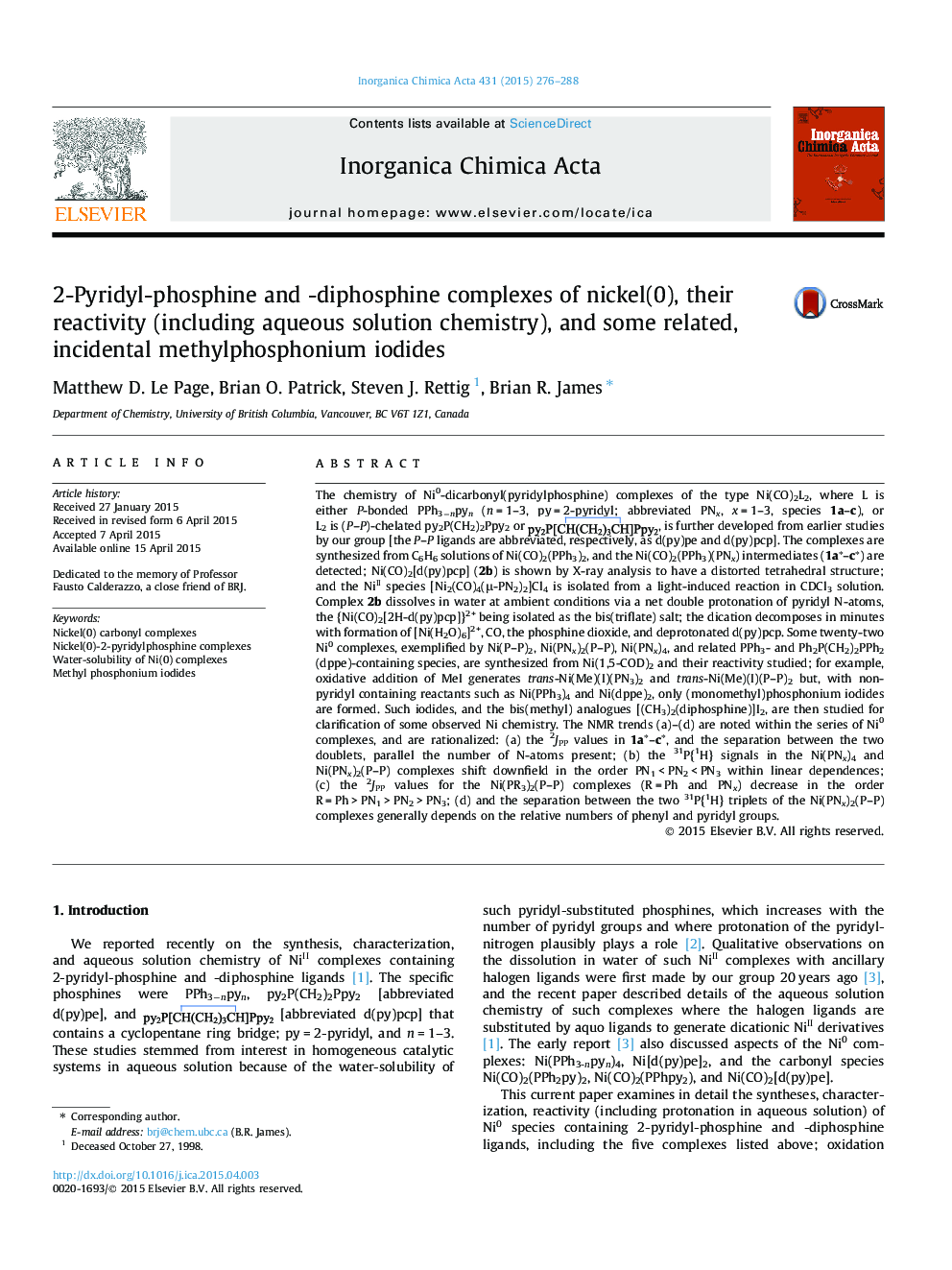| کد مقاله | کد نشریه | سال انتشار | مقاله انگلیسی | نسخه تمام متن |
|---|---|---|---|---|
| 1307952 | 1499158 | 2015 | 13 صفحه PDF | دانلود رایگان |
• Chemistry of Ni0 complexes with o-pyridyl-phosphines and -diphosphines expanded.
• Water-solubility results from protonation of pyridyl groups.
• Trans oxidative addition of MeI to Ni0 species established.
• In the absence of a pyridyl substituent, MeI and Ni0 species form (methyl)phosphonium iodides.
The chemistry of Ni0-dicarbonyl(pyridylphosphine) complexes of the type Ni(CO)2L2, where L is either P-bonded PPh3−npyn (n = 1–3, py = 2-pyridyl; abbreviated PNx, x = 1–3, species 1a–c), or L2 is (P–P)-chelated py2P(CH2)2Ppy2 or , is further developed from earlier studies by our group [the P–P ligands are abbreviated, respectively, as d(py)pe and d(py)pcp]. The complexes are synthesized from C6H6 solutions of Ni(CO)2(PPh3)2, and the Ni(CO)2(PPh3)(PNx) intermediates (1a∗–c∗) are detected; Ni(CO)2[d(py)pcp] (2b) is shown by X-ray analysis to have a distorted tetrahedral structure; and the NiII species [Ni2(CO)4(μ-PN2)2]Cl4 is isolated from a light-induced reaction in CDCl3 solution. Complex 2b dissolves in water at ambient conditions via a net double protonation of pyridyl N-atoms, the {Ni(CO)2[2H-d(py)pcp]}2+ being isolated as the bis(triflate) salt; the dication decomposes in minutes with formation of [Ni(H2O)6]2+, CO, the phosphine dioxide, and deprotonated d(py)pcp. Some twenty-two Ni0 complexes, exemplified by Ni(P–P)2, Ni(PNx)2(P–P), Ni(PNx)4, and related PPh3- and Ph2P(CH2)2PPh2 (dppe)-containing species, are synthesized from Ni(1,5-COD)2 and their reactivity studied; for example, oxidative addition of MeI generates trans-Ni(Me)(I)(PN3)2 and trans-Ni(Me)(I)(P–P)2 but, with non-pyridyl containing reactants such as Ni(PPh3)4 and Ni(dppe)2, only (monomethyl)phosphonium iodides are formed. Such iodides, and the bis(methyl) analogues [(CH3)2(diphosphine)]I2, are then studied for clarification of some observed Ni chemistry. The NMR trends (a)–(d) are noted within the series of Ni0 complexes, and are rationalized: (a) the 2JPP values in 1a∗–c∗, and the separation between the two doublets, parallel the number of N-atoms present; (b) the 31P{1H} signals in the Ni(PNx)4 and Ni(PNx)2(P–P) complexes shift downfield in the order PN1 < PN2 < PN3 within linear dependences; (c) the 2JPP values for the Ni(PR3)2(P–P) complexes (R = Ph and PNx) decrease in the order R = Ph > PN1 > PN2 > PN3; (d) and the separation between the two 31P{1H} triplets of the Ni(PNx)2(P–P) complexes generally depends on the relative numbers of phenyl and pyridyl groups.
The synthesis, reactivity toward H2O, and oxidative addition chemistry of Ni0 species containing 2-pyridyl-phosphine and -diphosphines are reported; in the absence of a pyridyl group, the MeI reactions give methyl(phosphonium) iodides.Figure optionsDownload as PowerPoint slide
Journal: Inorganica Chimica Acta - Volume 431, 24 May 2015, Pages 276–288
